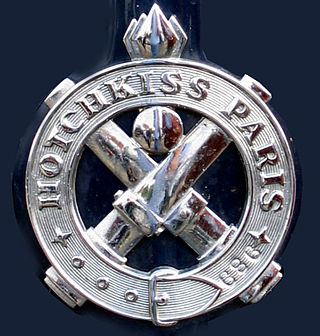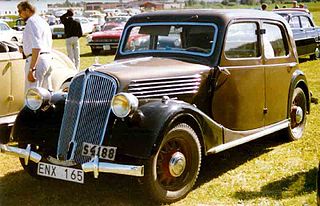Details and Evolutions
The Primastella was released in 1932 with a 6 cylinders 16CV engine, derived from that of the Renault Vivastella but with a slightly smaller cylinder bore. The Primastella "Type PG8" was produced until 1933.
At the 27th Paris Motor Show, in October 1933, the Primastella "Type PG10" appeared. [1] It featured Renault's "aérodynamique" body style, most readily distinguishable by a sloping tail in place of the very vertical one of the earlier Primastella PG8. [1] It was the manufacturer's intention to provide new "aérodynamique" bodies across their range, and this they achieved by the middle of 1934, but the Primastella and the larger cars were already sporting this new look before the end of 1933. [1]

Unic was a French manufacturer founded in 1905, and active as an automobile producer until July 1938. After this the company continued to produce commercial vehicles, retaining its independence for a further fourteen years before being purchased in 1952 by Henri Pigozzi, who was keen to develop Unic as a commercial vehicle arm of the then flourishing Simca business.
Berliet was a French manufacturer of automobiles, buses, trucks and military vehicles among other vehicles based in Vénissieux, outside of Lyon, France. Founded in 1899, and apart from a five-year period from 1944 to 1949 when it was put into 'administration sequestre' it was in private ownership until 1967 when it then became part of Citroën, and subsequently acquired by Renault in 1974 and merged with Saviem into a new Renault Trucks company in 1978. The Berliet marque was phased out by 1980.

The Billancourt engine was an automotive engine designed by Renault for the Renault 4CV, used subsequently until 1985. It later received the internal code "B", for Billancourt. The "sport" version is called Ventoux engine.

Delage is a French luxury automobile and racecar company founded in 1905 by Louis Delâge in Levallois-Perret near Paris; it was acquired by Delahaye in 1935 and ceased operation in 1953.

The Renault Juvaquatre is a small family car / compact car automobile produced by the French manufacturer Renault between 1937 and 1960, although production stopped or slowed to a trickle during the war years. The Juvaquatre was produced as a sedan/saloon until 1948 when the plant switched its full attention to the new Renault 4CV. During the second half of 1952 the plant restarted production of the Juvaquatre sedans/saloons for a period of approximately five months.

Automobiles Hotchkiss manufactured luxury cars in Saint-Denis, Paris between 1903 and 1955 and trucks between 1936 and 1970. It was a subsidiary of the French company Hotchkiss et Cie. The badge for the marque showed a pair of crossed cannons, evoking the company's history as an arms manufacturer. Hotchkiss also briefly built cars under the Hotchkiss Grégoire brand after the war. Hotchkiss went through a number of mergers and takeovers after the war and the brand disappeared in the 1970s; its successor companies went on to eventually form the partially state-owned Thales Group.

The Renault Vivastella was an executive car introduced by Renault in October 1928 and produced for the model years 1929 - 1939.

The Renault Primaquatre is an automobile produced from 1931 to 1941 by Renault. It was the last car built before Louis Renault's death in 1944.

Lorraine-Dietrich was a French automobile and aircraft engine manufacturer from 1896 until 1935, created when railway locomotive manufacturer Société Lorraine des Anciens Etablissements de Dietrich et Cie de Lunéville branched into the manufacture of automobiles. The Franco-Prussian War divided the company's manufacturing capacity, one plant in Niederbronn-les-Bains, Alsace, and the other in Lunéville, Lorraine.

The Peugeot 301 is a four-cylinder large family car produced by Peugeot between 1932 and 1936.

The Peugeot 601 was a range-topping car produced between 1934 and 1935 by Peugeot. It had its formal launch on 5 May 1934 and marked a return by the manufacturer to six-cylinder engines.

The Renault Celtaquatre is a small family car produced by the French manufacturer Renault between 1934 and 1938. Although French, it took some of its styling cues from American cars of the time. Its rounded silhouette gave it the nickname “Celtaboule” ("Celtaball").

The Monaquatre was a small family car assembled by Renault between 1931 and 1936. It used a conventional front-engine, rear-wheel-drive configuration and was powered by a four-cylinder water-cooled engine.

The Renault Monastella was a compact luxury car manufactured between late 1928 and 1933 by Renault. It shared the mechanical elements and bodywork options of the Renault Monasix but was differentiated by superior levels of finish and equipment.

The Delage D6 is a six-cylinder luxury car produced by the manufacturer between 1930 and 1940 and again, after the war, between 1946 and 1953. For much of this time it was the company’s principal or, from 1946, only model.

The Nervastella is a large automobile constructed by Renault between 1930 and 1937. It was used as a state car and pictures of the president of the French Republic sitting in a Nervastella can therefore be seen in newsreels from the mid-1930s.

The Vivaquatre is a car produced by Renault between 1932 and 1939. Its large 4-cylinder engine placed it initially in the 10CV car tax class, though a larger engine later made it a contender in the 11CV class.

The Renault Vivasport was a 6-cylinder engined executive automobile introduced by Renault in September 1933 and produced till April 1935. A larger engined version was produced between December 1934 and February 1938. As with many Renaults during the 1930s, type changes as well as small often cosmetic facelifts and upgrades appeared frequently.

The Caudron C.430 Rafale was a fast, two seat French touring monoplane. Soon after its first flight in 1933 it set an international class speed record.
The Škoda 637 is a Czechoslovak mid-size car that was made by Škoda from 1932 to 1935.
This page is based on this
Wikipedia article Text is available under the
CC BY-SA 4.0 license; additional terms may apply.
Images, videos and audio are available under their respective licenses.


















